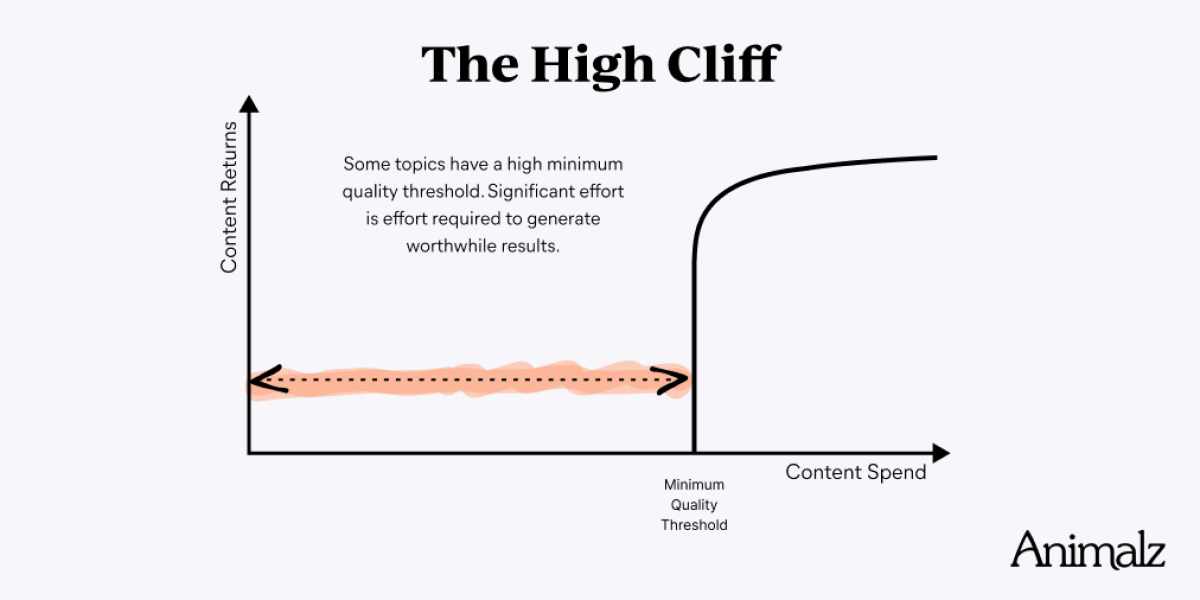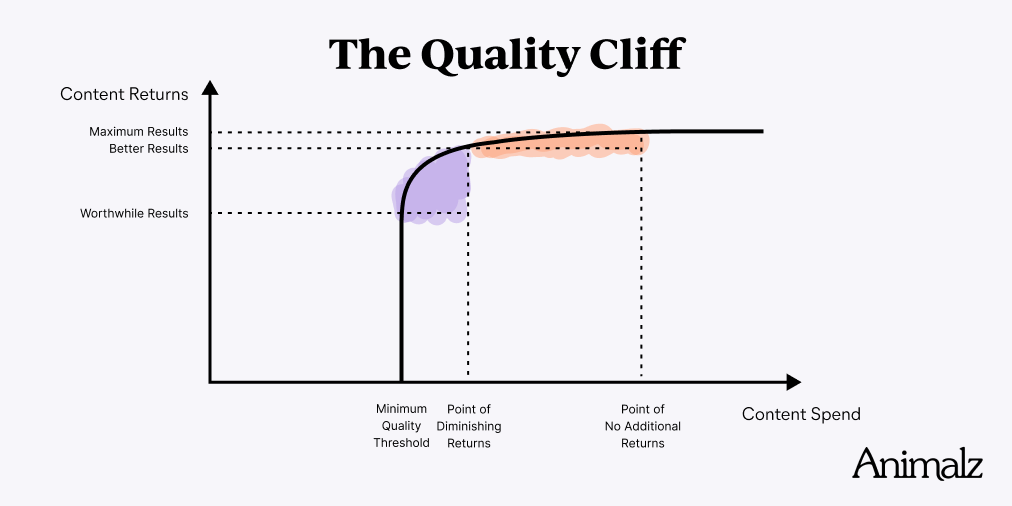When does it make sense to invest in content quality? When is the time and expense—the research and interviewing, editorial review, structuring and optimisation, UX and design—worthwhile? And when is it not necessary?
These are hard questions to answer, and something every marketing leader has to wrestle with. Here’s a framework to help.
The Quality Cliff
All content has a minimum quality threshold that needs to be surpassed in order to generate any results. The “height” of that threshold is influenced by a host of factors: the maturity of the search results, and the quality of the existing competition; the complexity of the topic; the expertise and expectations of the audience.
All marketers need to aim to clear the minimum quality threshold for every article. Falling short of this threshold represents a complete waste of resources. Take SEO content: if you fail to meet the basic search intent, you can expect to join the 91% of content that generates no visitors.
Beyond that threshold, better quality usually generates better results, but at a diminishing rate. There is a sweet spot where extra time and energy generate meaningfully better results, where the juice really is worth the squeeze. But past a certain point, it takes lots of extra time and effort to eke out even a tiny improvement in performance.
All content also has a ceiling, a maximum potential benefit. At a certain point, spending extra time and energy on an article will make no difference to the results it generates. There are only so many people searching for a given query.
Here’s what that looks like in pretty graph form:

As a marketing leader, you need to balance great results with efficiency. Marketing is constrained optimization. Your job is to reconcile your company’s limitless growth goals—traffic, sign-ups, revenue—with a limited set of resources.
That means taking a nuanced approach to quality. Consistently undervaluing the need for quality risks dismal results; pursuing quality at all costs winds up expensive and over-engineered. You need to evaluate every topic and campaign on a case-by-case basis.
“Consistently undervaluing the need for quality risks dismal results; pursuing quality at all costs winds up expensive and over-engineered.”
That means asking:
Where is my quality cliff? For this topic, what is the minimum effort required to generate any results? What does the competition look like? What are the reader’s expectations?
How efficient do I want to be? Am I incentivised to get the best results possible, even if it costs a lot to achieve? Or am I better served by aiming for “good enough”, and focusing extra energy on new topics?
What is the performance ceiling for this article? What are the best possible results I can expect from this article? Am I close to those results, or is there lots of upside for improvement?
Run this thought experiment with your next article, and you’ll realise that content generally falls into one of two camps.
The High Cliff
Many articles can be visualised as possessing a high minimum-quality threshold: it will take substantial investment to generate any return, and a greater focus on quality—research, editorial review, design—is both necessary and desirable.

Many topics (perhaps even most) fit into the high cliff group. You’ll notice this high minimum standard whenever you find yourself:
Marketing to an experienced audience. The more experienced, savvy, and discerning your target audience, the more resources are required to climb the quality cliff. Generic SEO content won’t cut it for an audience of C-suite buyers: you need opinionated, expert content based on solid research and interviewing.
Competing against established skyscrapers. Content marketing is a mature ecosystem. Many SERPs are highly-contested. Incumbent articles are sitting on a decade’s worth of accumulated backlinks and brand recognition. Basic information was long ago covered. In these situations, it’s necessary to find a new angle, or new data point, to bring to the discussion.
Covering mission-critical topics. Some topics simply warrant special attention: pages that target core product keywords, brand marketing efforts that need to reflect your company’s voice and ethos. Extra time spent here is worthwhile.
Much of the work we do with customers falls into this category. We interview SMEs, analyse and challenge industry truisms, work through rigorous editorial review—and the investment pays off, allowing us to clear a high-quality bar that most companies fall short of. We summit the cliff, instead of falling short.
The Low Cliff
Other articles can be visualised differently, possessing a low minimum quality threshold. Here, extra expenditure beyond the minimum very quickly enters the realm of diminishing returns. Extra effort does generate better results, but only just.

Ten years ago, most topics fell into this camp, but today, there are fewer situations that create a low-quality threshold. You’ll notice this when:
Targeting non-competitive SERPs. Some industries are late to the content marketing game. In these situations, simply matching the user intent with clear, coherent information is enough to pass the minimum quality threshold and unlock the lion’s share of results (at least until your competitors wise up).
Targeting long-tail keywords. In a similar vein, niche, low-competition keywords can usually generate decent results with relatively low effort. For a few dozen clicks per month, it may not make sense to invest a fortune into content quality.
Testing new topic areas. If you’ve already targeted your “core” product keywords, you might want to experiment with an adjacent topic. This is high-risk content, and investing a ton into rigorous editorial processes and design might be a gross misallocation of resources. Instead, it might be better to invest the bare minimum required to achieve your goal: assessing the viability of these topics.
In these situations, the benefit of extra effort isn’t clear-cut. It may be in your company’s interest to wring out every cent of revenue from its content (no matter the cost)—but it may be better to focus that energy on a different article, or a different campaign.
How to Justify Quality
We all want to create great things, but funnelling limited resources into quality can be hard to justify. Sometimes, it’s enough to lead with conviction and act on faith. There is an advantage to doing things that can’t readily be justified with metrics and KPIs. As we’ve written before,
“The ability to justify a decision through concrete data means that other people can also justify (and act on) the same data. By the time something is measurable, the greatest opportunity may already be over.”
But for situations where resources are scarce or executives are sceptical, it can help to bring a framework like the quality cliff to the table. It helps prove the idea that in many situations, quality isn’t just a nice-to-have: it’s an essential tool in your arsenal, a prerequisite to getting any results from marketing efforts.
